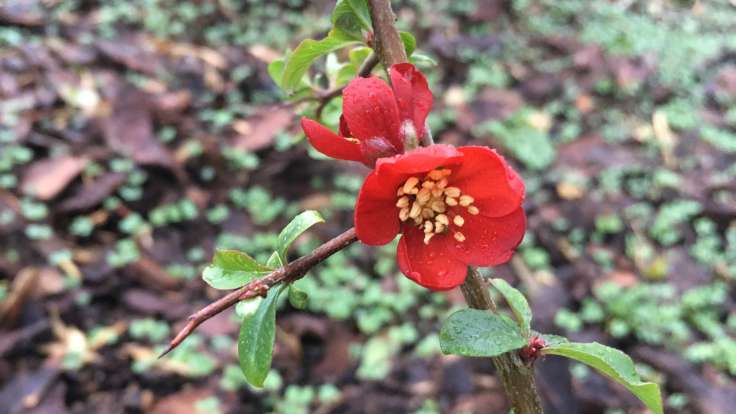
Chaenomeles x superba 'Crimson and Gold', emblem of the forest garden
The itinerary for my forest garden tours and workshops, with a link to a “live” page that will be kept up-to-date.
We had our first forest garden tour and workshop last week, via Airbnb. A bit nerve-wracking but eminently enjoyable. I used the same itinerary for both the two hour tour and the six hour workshop. I feel the cyclical process works well in both situations, the workshop is an extension with more detail and practical applications.
This is a snapshot of the intinerary, I’m keeping a “live” version on Simplenote updated, as it’s easier to print from http://simp.ly/publish/wj614M
FGW itinerary
A. Theory
B. Practice
C. Timetable
D. Reference
A. Theory
1. Definition of a forest garden
- Productive: produce, layers
- Sustainable: wildlife, pests, nutrients, inputs, carbon
- Low maintenance: watering, weeding, digging, fertilising, compost
Wildlife orchard underplanted with edible shrubs & perennial vegetables. 7 layers.
2. Start with wants
- Harvest: fruits, nuts, seeds, spices, herbs, mushrooms, poles, canes, string
- Space: People centered “who, what & when”
- Time
- Money
3. Climax vegetation
- Woodland -> Forest garden -> Orchard -> Pasture -> Arable
- Increased: energy, fragility, uniformity, maintenance, greenhouse gas emissions
Gently balance the garden
On the cusp of woodland
With minimal effort
4. Efficiency
Energy input:output
* Animal 1: 0.8
* Arable 1: 4.0
* Forest garden 1:40.0
B. Practical
1. Survey
- Measure aspects: soil, water, boundaries, paths, slopes, orientation, views, footpaths, utilities, structures, access, privacy etc
- Mapping: tape measure, satellite, OS map - accuracy
2. Plan
- List what you want & have (three W’s; time, money, space). Zoning.
- Purpose of plan: fit the use and trees with the space.
- Plan access, windbreaks, canopy, name areas (computer or paper).
3. Propagate
- Start ground cover & windbreaks now
- Rudimentary propagation bed. Flowers & veg!
4. Windbreaks
- Calculate position, height, width (nurse tree)
- Choose - aspect, light, soil
5. Canopy
Critical. Spacing, pollination, protection
6. Sheet mulch
Area, material, time
7. Shrubs
Spacing, light, access. Mark chalk circles.
8. Ground cover
Wood chip, spacing, shade, temporary ground cover
C. Timetable
1. Workshop timetable
- 10-11: Tour - meadow, coppice, Ornamental Forest Garden, Forest Garden One definition
- 11-12: Survey, plan
- 12-1: Lunch
- 1-2: Plan
- 2-3: Practical propagation, shrub
- 3-4: Practical ground cover
2. Tour timetable
- Definition: Fruit Triangle example
- Survey, Plan: polytunnel area
- Propagation, windbreaks: Ornamental Forest Garden
- Canopy, Shrub, Ground cover: Forest Garden One
D. Reference
- Creating a Forest Garden, book by Martin Crawford
- Plants For A Future www.pfaf.org
- Orange Pippin fruit directory www.orangepippin.com
- Horticultural Myths puyallup.wsu.edu/lcs/
- Rootstock reference www.forestgarden.wales/blog/rootstock-reference
- Edimentals edible plants www.edimentals.com
- Sun Surveyor app www.sunsurveyor.com
- Inkscape drawing software www.inkscape.org
- QCAD software www.qcad.org
Jake Rayson
- Forest Garden Wales
- www.forestgarden.wales
- hello@forestgarden.wales
- Twitter @NatureWorksGdn
- Facebook @NatureWorksGarden
- Please leave a review on Airbnb, Tripadvisor or Facebook, thank you 🙂
This page online: http://simp.ly/publish/wj614M